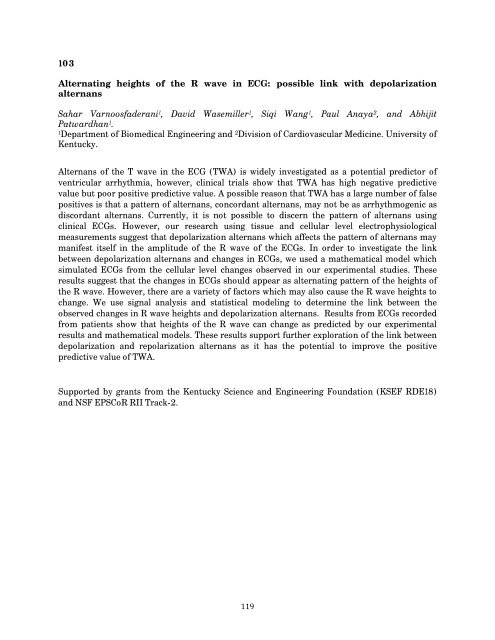2017 Cardiovascular Research Day Abstract Book
You also want an ePaper? Increase the reach of your titles
YUMPU automatically turns print PDFs into web optimized ePapers that Google loves.
103<br />
Alternating heights of the R wave in ECG: possible link with depolarization<br />
alternans<br />
Sahar Varnoosfaderani 1 , David Wasemiller 1 , Siqi Wang 1 , Paul Anaya 2 , and Abhijit<br />
Patwardhan 1 .<br />
1<br />
Department of Biomedical Engineering and 2 Division of <strong>Cardiovascular</strong> Medicine. University of<br />
Kentucky.<br />
Alternans of the T wave in the ECG (TWA) is widely investigated as a potential predictor of<br />
ventricular arrhythmia, however, clinical trials show that TWA has high negative predictive<br />
value but poor positive predictive value. A possible reason that TWA has a large number of false<br />
positives is that a pattern of alternans, concordant alternans, may not be as arrhythmogenic as<br />
discordant alternans. Currently, it is not possible to discern the pattern of alternans using<br />
clinical ECGs. However, our research using tissue and cellular level electrophysiological<br />
measurements suggest that depolarization alternans which affects the pattern of alternans may<br />
manifest itself in the amplitude of the R wave of the ECGs. In order to investigate the link<br />
between depolarization alternans and changes in ECGs, we used a mathematical model which<br />
simulated ECGs from the cellular level changes observed in our experimental studies. These<br />
results suggest that the changes in ECGs should appear as alternating pattern of the heights of<br />
the R wave. However, there are a variety of factors which may also cause the R wave heights to<br />
change. We use signal analysis and statistical modeling to determine the link between the<br />
observed changes in R wave heights and depolarization alternans. Results from ECGs recorded<br />
from patients show that heights of the R wave can change as predicted by our experimental<br />
results and mathematical models. These results support further exploration of the link between<br />
depolarization and repolarization alternans as it has the potential to improve the positive<br />
predictive value of TWA.<br />
Supported by grants from the Kentucky Science and Engineering Foundation (KSEF RDE18)<br />
and NSF EPSCoR RII Track-2.<br />
119


